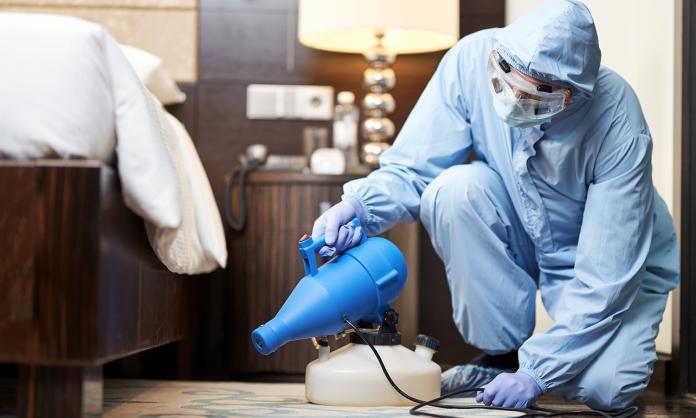As Victoria entered a seven-day lockdown to contain a rapidly growing cluster from yet another leak from hotel quarantine, Scott Morrison put on his best “fatherly” tone of voice. He praised the “steadfast resilience of the Australian people”, along with everyone who worked in the “many rings of containment” that “protect Australians from the virus”.
We should be clear that Morrison’s main contribution to these “many rings of containment” has been to attempt to destroy them. His government’s constant attacks on Victoria’s long lockdown last year would have cost countless lives if heeded. More recently, as a federal election approaches, Morrison has had to adapt to the political reality that lockdowns to prevent mass deaths have been popular. However, his government is so far refusing to give the economic aid, such as JobKeeper and extra JobSeeker allowances, needed to help workers through them.
There’s also Australia’s federal vaccine rollout, handed to private contractors under a shroud of “commercial in confidence” secrecy. These contractors have followed procedures that left many GPs meant to administer the vaccine baffled—and without vaccines. The government responded to the criticism by appointing Commodore Eric Young of the Royal Australian Navy as the figurehead of vaccine distribution. This is a classic Scott Morrison move: if you can’t actually be good, you can at least try to look decisive by appointing a bloke in a military uniform for the health minister to stand next to at press conferences, as he stammers his way through his non-answers.
And there’s the absolute failure of the federal government to construct a functional quarantine system, essential to keeping the virus at bay in Australia. The Australian government spends well over a billion dollars per year detaining a few hundred refugees in offshore detention, subjecting people who pose no threat at all to the torture of indefinite prison. Yet it has failed to build a single facility to keep a deadly, once-in-a-century pandemic out of the country.
Barbed wire and racism are worth spending money on, it seems. Protecting the lives of ordinary people, not so much. No doubt there’s also the cynical calculation for Morrison that it’s better politically to allow state governments to take the heat on any breakdowns in hotel quarantine.
There has been a string of these failures. Partly they are the result of a privatised model of service delivery that has become unquestioned orthodoxy for both Liberal and Labor governments. Famously, the Andrews Labor government initially gave the job of securing quarantine hotels to fly-by-night security companies notorious for underpayments, which gave their subcontracted staff close to zero health and safety training. Victoria’s second wave was the result of this approach.
At least as big a problem is the failure of federal and state governments over the past year to build quarantine facilities that are fit for purpose. Victoria is now paying the price for this failure.
The current outbreak originated in a quarantine hotel in Adelaide. According to a report by the South Australian Health Department, on 3 May a COVID-positive person in the Playford Hotel opened their door, picked up some food from the corridor, and closed their door again. Eighteen seconds later, a 30-year-old Melbourne man staying on the same floor did the same thing. Later in the day the same sequence played out, with a twelve-minute gap between the two doors opening and closing.
This is all that it took for the man from Melbourne to become infected. He travelled home to the northern suburbs of Melbourne the next day. Since then, the virus, which spread through such a fleeting air transfer in a hotel corridor, has spread to workplaces, gyms, sporting grounds, cafes, pubs and nightclubs all over Melbourne—more than 150 exposure sites in total.
It’s yet another, potentially deadly, reminder of the crucial need to take airborne transmission of the coronavirus seriously, especially in a quarantine hotel. And it’s a reminder of the urgent need to build more facilities similar to the former construction site camp being used for quarantine at Howard Springs in the Northern Territory. At Howard Springs, the accommodation is in detached demountable huts that don’t share a closed corridor or an air conditioning system. Because of this, aerosol transmission is much more unlikely. The Northern Territory is the only jurisdiction in Australia which has not had a serious breach of hotel quarantine.
Official acknowledgement of airborne transmission has been slow and grudging in Australia and elsewhere. This is because it’s relatively cheap to pay someone a minimum wage to wipe a cloth over a hard surface, while taking the role of airborne transmission seriously means a total and costly overhaul of air conditioning and ventilation systems.
Victoria has been no exception to this reluctance to take airborne spread seriously and follow through on the consequences. It was only at the start of May this year—fourteen months after the first lockdown—that acting premier James Merlino declared: “The best time to start an alternative quarantine was twelve months ago, the next best time is now”. Which raises the question: If the best time to build a facility was twelve months ago, what has the Victorian government been doing in the meantime, while the federal government has refused to lift a finger?
Though a role for airborne transmission was acknowledged by Victoria’s Chief Health Officer Brett Sutton last year, movement on a workable solution for it has been criminally slow. A five-day Melbourne-wide lockdown was triggered in February when a cluster of 22 cases spread from staff at the Holiday Inn quarantine hotel, most likely due to poor ventilation and a failure to provide fitted masks. Incredibly, according to the Australian Medical Association, the Victorian government didn’t carry out a ventilation audit at the Holiday Inn or at many similar facilities before they became quarantine hotels.
This slowness to acknowledge and act on airborne transmission costs lives and health. Taking the threat seriously will cost money. The Victorian government is now negotiating with the federal government to fund a new Howard Springs-style quarantine facility on Melbourne’s outskirts for between $200 million and $700 million. It will likely be completed as the whole population finally gets vaccinated. But better late than never.
A range of things now seems to be working much better than last year—more than 50,000 tests per day can be carried out (though often after wait times stretching to five hours) and the contact tracing appears to be more sophisticated, after the government relied on privatised, outsourced contractors and ineffective software for most of the past year. However, the overall response over the last 12 months has been hampered because the state government was woefully underprepared for all aspects of managing a serious outbreak.
The Age reported that the government had been repeatedly told in 2019 that the state’s public health unit was the worst resourced in the country, one source stating: “Essentially, six nurses and a few team leaders had to set up the entire case management, outbreak management and contact tracing groups, train up all the new people, ask for physical space, computers ... fix all the mistakes of the new people”.
The deficiencies are not simply a hangover of previous Liberal governments. Andrews, a former health minister, has been premier for more than six years. In that time, the Victorian health and hospital systems have remained enormously stretched. Unions won some steps forward on pay and classifications in public sector enterprise agreements, but the just-in-time, “lean production” model introduced in the 1990s remains intact.
As a result, Victorian health services and hospitals were as overwhelmed as others around the country during last year’s COVID-19 surge and its aftermath, multiple media stories detailing unmanageable workloads for staff and dangerous waiting times for patients.
It’s not as though the money isn’t there for public health (and to support workers during a lockdown, for that matter). The first day of the Victorian lockdown coincided with the release of the annual Rich 200 list in the Australian Financial Review. The total wealth of Australia’s richest 200 today is $479.6 billion—an increase of $137 billion in wealth since the last Rich 200 list before the pandemic, in May 2019. The ten richest people in Melbourne have increased their wealth by a combined $6.6 billion in just six months.
Redirecting this staggering wealth to fund vital services would be one of the central pillars in a socialist response to the pandemic. Turning society’s enormous resources to building health and quarantine facilities would enable repatriation flights and medical aid to people in the region and around the world. Ending shonky privatised services and building government-owned facilities, under the control of the workers who make them function, would be an enormous step forward.
Scott Morrison and his gang will always prioritise profits and “business as usual” over human life. Labor has failed to challenge these priorities in practice—as evidenced by its foot-dragging on tackling aerosol spread, its failure to rapidly build quarantine facilities and its half-hearted approach to taxing the rich to pay for what’s needed. In contrast, a socialist response to the COVID crisis involves workers, in health care and beyond, organising and mobilising to pressure governments to break with business as usual and spend what’s needed to preserve life and health.









